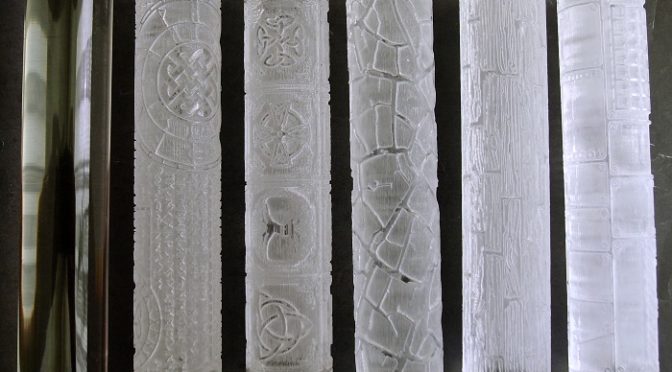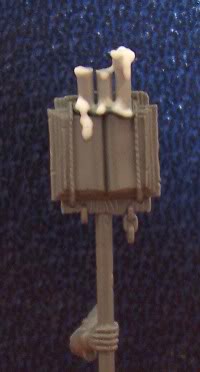I would like to share with you my first impressions of Textured Rolling Pins that I purchased recently from Green Stuff World.
I bought Textured Rolls Pack v2.0 which contains 6 rolls:
– 1 rolling pin plain (no texture) – used for extending the putty to smoothen the surface before impressing with other textured rolling pins
– 1 rolling pin Runic
– 1 rolling pin Celtic
– 1 rolling pin Frozen
– 1 rolling pin Wood planks
– 1 rolling pin Factory ground

They are about 140mm long and 25mm wide.
The cost of this set (including shippment) is 50 EUR (59 USD), which is not cheap. But when you consider how many bases can you make with those tools…
I made first tests using Runic rolling pin. I didn’t have anything else at hand, so I used my daughter’s modelling clay – hence those vivid collors. Don’t worry – it will be painted 🙂
After extending and flatting the clay to a small disc (in size of 30mm base, about 3mm thick) I transfered the texture to the putty.
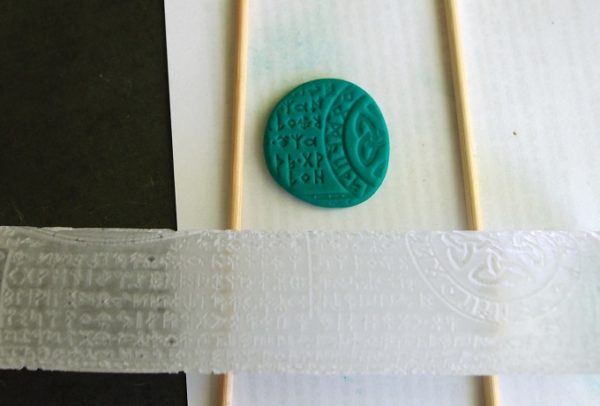
As you may see, I used 2 toothpicks to get even surface when rolling the pin. It looked really OK. Sculping It would certainly take me a lot of time! I made a few more and put my production to boiling water for about 25 minutes to harden it.
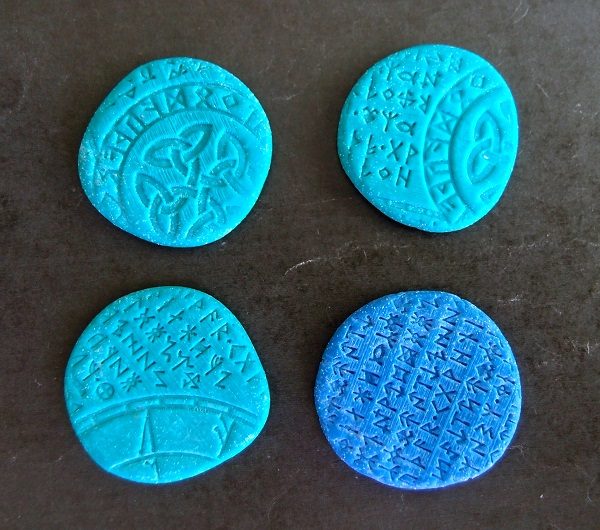
After cooling down I crushed the edges to make them more irregular and sharp. Then I glued the textured discs to the bases using epoxy glue. I broke some discs to make it more interesting and to suggest ancient provenance of the stone floor.

Here is how two of the bases looks painted:
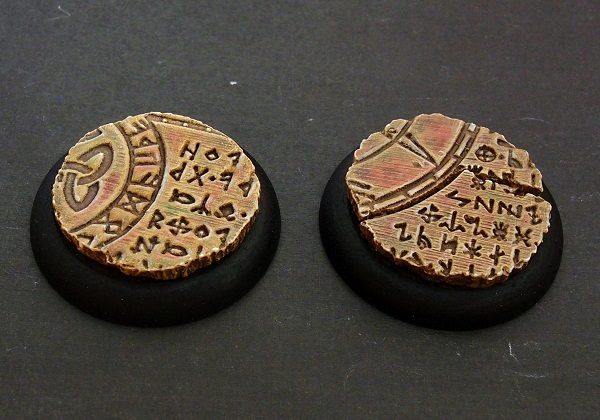
It’s not much except base paint, wash and drybrush. I wanted to paint them as quick as possible – there are much more bases to make! I think the effect is really good, considering that “sculpting” 4 bases and painting 2 of them took me about 45 minutes.
What minis will I put on those bases? I’ll show you that in my next post 😉
How to make candles – tutorial
It’s been some time since Urbik described how to make candles for your miniatures. Still, after all this time the tutorial may still be interesting for many hobbyists, so we’re making it available again. Urbik wrote:
Hello!
I thought that since I already registered here and have been browsing the forum for a few days, it would be nice to write something too. And because I have a lot of time, I decided to describe my own way of creating candles in scale of Warhammer Fantasy Battles miniatures, like the ones I presented during Polish edition of Golden Demon.
Note: If anybody had a similar idea and published it before me in the internet/paper/radio/poster/leaflet/TV/another medium, I would like to explain that this idea is my own and hasn’t been stolen from anyone. In case of any similarities, I am not responsible. 😉
OK, so you want to know how to make candles? Let’s get started!
What we need
- wire or a piece of “something” of 1-1.5 mm diameter
- thin string or thread (much thinner than the wire above)powyżej)
- PVA glue
- greenstuff
Step 1
At the very beginning we have to decide about the size of our candles. After a few attempts I found that their standard height would range from 3 to 6 mm.
We divide the wire (or “something” else) into pieces of our chosen length. These bits will become the main (wax) parts of our candles. I used a chopped spear of an Empire soldier, something that I have a lot of, so I could use it with no regrets. 😉
Step 2
We make a small greenstuff ball (proportional to the size of our candle) and press it to a chosen part of our model. We put a piece of wire into it and wait for the greenstuff to harden. Whe wire is to become our candle.
It looks more or less like this:
Step 3
Now it’s time for the most important part in the whole process of candle creation. Sounded very serious, didn’t it? 😉
Because burning is the most important job of a candle, we should create a few drips of wax – just like we tend to see on real candles.
We’re going to use PVA glue for this purpose. We thin the glue down a bit with water (don’t overdo it!) so it has convenient thickness for us to work with. Then we use a toothpick (or some other little thing) to apply some glue onto the candle body, creating “spots” in several places of our choice. When the first application of glue is dry, we can add some more in the same places. Usually it’s enough, but if we want even more prominent drippings, we can add even more layers.
Step 4
Now it’s time for proverbial icing on the cake. What would a candle be without a wick?
We make a wick from thread (which can be hardened with some superglue) or thin string. Then we glue it to the top of our candle with strong glue.
Step 5
Painting! As we should know from our experience, candles can have very diverse colors. And I don’t really mean cheap candles in bad taste that you can buy at fairs, but different colors that can be spotted in various lighting conditions.
I tend to use two ways of painting my candles:
Method 1:
- basecoat of Rotting Flesh (maybe slightly darkened with a little black or Catachan Green)
- highlight up to white
Method 2:
- basecoat of Bleached Bone (also darkened – for example with light brown)
- highlight up to white or to Bleached Bone (if the basecoat was darker than that)
This time I decided to use the first method, which is the best imitation of wax in my opinion. I recommend using naturally smooth transition of colors, without rapid changes or radical contrasts. The results may look like this:
Done!
That’s it. As you can see the technique I use to create candles for my miniatures is not that complex and one doesn’t need to prepare more greenstuff and then remove excess with scalpels. How precise your approach is going to be depends only on you.
Such candles look great on religious-themed models – like flagellants, war priests or inquisitors.
It’s a pretty original method of making the model look more unique and interesting, and many Games Workshop models don’t include candles at all. Well, there are some exceptions, but they only prove the general rule 😉
I hope you find this tutorial useful and now you know how to make candles for your miniatures.
Regards,
— Urbik
How to paint ruins bases – tutorial
In this tutorial explaining how to paint ruins bases from Micro Art Studio, I’m going to show you two of many possible colour schemes which you can use while painting ruins – first one will be with standard grey colours, like if you’re in some sort of castle (and later on I’ll call grey bases “castle bases”), and the second one will be “desert ruins” – some kind of old temple/church, once great, now forgotten. So, without any more introductions, here we go:
How to paint ruin bases: The ground
Step 1:
First thing you need to do, is basecoat your bases. I did it with Vallejo 950 Black, just because I ran out of both Citadel paint and spray:
Step 2:
So, now what to do next… Which part, which element now? Well, first thing you want to ask yourself, is: How much time do I want to spend on 1 base? Is it 1 minute? Maybe 5? Can I spend 20 minutes on 1 base? And, most importantly, will it be worth that time?
Well, let’s assume that we want to do it fast, without going back to destroyed elements, because we must do 200 of them. In that case I suggest you to make the deepest parts of the base – in this particular case, the earth. I used Citadel brown colour Mournfang Brown, old Bestial Brown, which I applied normally on specific parts. Remember – you don’t have to be precise at this part, so don’t waste your time trying not to paint stones:
Step 3:
After that step was done, I decided that I’ll create some shadows on the earth, to make deeper parts darker. I could just drybrush those parts where the earth should be brown instead of painting it, leaving black shadows everywhere – but I want dark brown shadows, not black.
That’s why I decided to use Citadel Agrax Earthshade shade, which I applied on brown parts. The same effect I could accuire using darker brown as a prime earth colour, and then drybrushing those parts with Mournfang Brown – pick your favourite method:
Step 4:
Next thing to do is light up the earth a bit – I mixed 1:1 Mournfang Bown and Citadel Ushabti Bone, and then applied it on brown parts with light drybrush:
Step 5:
To finish up the earth, I lightly drybrushed every brown part with pure Ushabti Bone – remember, make sure your brush is really dry, otherwise you’ll ruin the whole effect! It’s better to mix or even waste more paint that do everything from the beginning:
Step 6:
As the earth is done, we can go on. Next and last, in this particular case, thing we have to do, is paint stones. At this point I separated bases – 3 for grey bases, 2 for desert ones. From now on, we’ll split the tutorial into two parts – one about each kind of bases.
How to paint grey ruins bases
Step 7a:
While painting the earth you didn’t have to care about precision – now you have to. Especially near the painted brown earth. So I applied very gently 1 layer of Citadel Eshin Grey paint. I think that it’s the second darkest grey colour they offer, comparable to Mechanicus Standard Grey, which you can also use here. That’s how it looks (notice that we don’t care about the rims of base at all right now):
Step 8a:
After painting it with your favourite grey colour, I mixed 3 parts of Eshin Grey with 2 parts of Ceramite White, and then quite heavily drybrushed the whole base (but be careful, don’t destroy your beautiful earth!):
Step 9a:
Next step is to light it more – you can mix 2 parts of Eshin Grey with 3 parts of Ceramite White, or simply use colour named Administratium Grey. It will look pretty much the same.
Then again, drybrush the whole base – but now lightly. Pick your way with that – I decided that I’ll make sides of the base lighter. You can choose differently:
Step 10a:
The only thing to do now is to make one, final highlight – take your white paint and apply it very gently using drybrush on parts which were before treated with Administratium Grey. At this point, after you finish with white, you’ll also have to paint rim of the base with black colour – Abaddon Black from Citadel or any other black paint (like my 950 Vallejo black). And after doing so, your bases are done.
Here’s the final effect:
Let’s move on to the desert bases.
How to paint desert ruins bases
Step 7b:
Let’s move on from the common part about painting ground, as parts from basecoating up to fully painted earth are the same in both cases. Here again, while painting the earth you didn’t have to care about precision – now you have to. I used Citadel Tallarn Sand as a prime colour for those stones:
Step 8b:
Then I came up with an idea – why do I have to make it look like just plain stones with highlights, can’t I add anything catchy, something that will make my base special?
Well, if it’s old ruined temple why not some frescoes? You can make them as you want, with many colours or very few, big or small, untouched or very destroyed, simple patterns, complicated or just some letters. I made a simple pattern on the side of base – line of purple(Citadel Xereus Purple) and turquoise (Citadel Sotek Green) triangles accompanied with blacklining:
Step 9b:
As for something that is destroyed (in my case), frescoes also have to in bad shape. That’s why I “scratched” some frescoes paint from the edges of the base, and made some cracks inside the painting. After that, I used Citadel Seraphim Sephia shade to make shades all over the base (I skipped the earlier painted earth of course):
Step 10b:
Ok, frescoes are destroyed, bases have shading. Let’s move on a little bit, and start lighting things up. Before you’ll grab a brush, think for a while – how I want my base to be highlighted? Centre of it, just edges or maybe some other pattern?
I’ve decided to highlight edges and a little bit of centre of my base.
I used mix of 2:3 Ushabti Bone and Tallarn Sand, and then drybrushed the whole base lightly. Remember, you should also drybrush frescoes, but do it gently, otherwise you’ll ruin the whole effect by covering them fully:
Step 11b:
Then I reversed proportions, and made a mix of 3:2 Ushabti Bone and Tallarn Sand. After that, I heavily drubrushed the area of stones and very lightly frescoes:
Step 12b:
And at the end, I drybrushed whole base lightly with Citadel Ushabti Bone and painted the rims of the bases with black. That’s the end of making desert bases, here’s final effect:
Finished ruin bases
And so, here it is, the final effect of my work on 1 picture. A perfect bases for your Dwarf, Empire, Tomb King or any other army you want, which you can easily make by yourself in a matter of minutes!
List of used paints
- Abbadon Black, Vallejo 950 – Basecoat, frescoes blacklining
- Mournfang Brown – color of the earth
- Agrax Earthshade – Shade used on earth
- Ushabti Bone – Highlights on desert bases and earth
- Eshin Grey – Prime colour for castle bases
- Administratium Grey – highlights on castle bases
- Ceramite White – Highlights on desert and castle bases
- Tallarn Sand – Prime colour of desert bases
- Seraphim Sephia – Shade used on desert bases
- Sotek Green – frescoes triangles
- Xereus Purple – frescoes triangles
– Lemartes
Painting Hell Dorado Immortals warband – Tutorial
Welcome to the article devoted to painting a whole warband. I will try to give you a step by step photo report. And the main actors will be Immortals from Asmodee/Cipher Studios.
Stage 1: Know your models
So we spent few euro or dollars, bought some cool looking models and it is time to have a good look what did you get. Maybe there are some parts missing? Maybe there are some miscasts?
If everything is ok, then now is the last call to have an idea how to paint the warband. What theme or background story? What color scheme? What units? What bases?
In my case the answers are no theme, original red-gold scheme, all units, Scibor‘s bases. It makes putting such group easier when there is a clear idea in your head. I know I am not being original, but this is also a decision later to stick to. 😉
So I take a good look at all the miniatures and put in separate piles. I try to, without glue, put these together and see if the parts match. Now is the perfect time to think about conversions and to look for extra parts in your bits box. If you found something there, just put it on the pile.
Stage 2: Removing mould lines and putting models together
Those models are supposed to fight on the table and we all know what happens to them when transporting or falling over on the table. That is why I try to pin the parts together. Tools that I use:
The pins which will hold the parts together are done (or better cut) from paper clips:
There should be also a picture of super glue or any metal glue, that glues the metal parts in few seconds. 🙂
A word about mould lines… I hate them! To clean them, takes a lot of time, but I see no other way. This job takes plenty of time, but it is simple. Believe me, it is worth to clean the miniatures from them. Later they will take a lot of the miniatures’ beauty away. I spent 2 evenings to clean all the parts from mould lines, but this job needs to be done – even on tabletop miniatures! Now, when all the parts are separate and easy to reach, it is the best time to remove them. Later it will won’t be easier. 😉
So let’s move to some examples – this djin has be cleaned from mould lines and all the parts are together (so that I won’t forget anything).
First I try to glue the biggest parts, in this case it is the torso. You can see on the picture a small cut from pater clip (called a pin) and two holes (drilled by me) in both parts of the torso. Before you glue – try to pin the parts without glue – if it’s ok, put some glue on the parts and into the pinning holes. If not then maybe the pin is to long or the holes too small?
To be sure that you drill the holes in perfect positions on both parts, try this simple trick:
- Drill a hole in one part,
- Put some paint around the hole,
- Try both parts together (with your fingers, not glue),
- Remove the second part and you should see the exact place where to drill.
And there we have a finished cleaned and pinned djin.
While removing mould lines from a ‘froggy warrior’ I accidentally broke the lance into two parts. It happens quite often, when the parts are small and fragile.
So what did I do – first I finished removing all the mould lines:
… and drilled holes in both parts and pinned them:
I also had a bit of problems with glueing the small parts with the torso, but with the help from pincette it was much easier. Here are the horns that are supposed to go on the shoulder pads:
I stick glued and pinned models together on cork. It makes further steps, like cleaning/gap filling/painting, much easier. You can easily rotate the cork and not touch the miniature. Another benefit is that when you clean the miniature (more to come), it won’t get dirty or greasy from fingers.
At the end of this step we get something like this:
Stage 3: Preparing for painting
All miniatures are on cork, waiting to be painted. Before we go to this step, there are some more things to be done. Usually glued minis have gaps, holes that don’t look nice. With these tools I will fill them:
Here is a mercenary djin with filled gaps.
I must admit, that using liquid green stuff from Games Workshop helps a lot. Filling small gaps isn’t a problem, but sometimes the gaps are too big, just like here:
The best way is to use normal green stuff or any other putty.
Now we are almost ready with putting undercoat, almost… We were touching the miniatures with dirty hands and the miniatures need a wash, so that the undercoat spray will hold on the miniature better. It will also remove any fat or oils from manufacturing process. We just need an old tooth brush, soap and dish washing liquid.
Pour some hot water and gently wash the miniature. I had no problems will super glue losing its characteristic because of water, so I can say it is safe!
Stage 4: Priming
Give the miniatures a day or two to dry and now we can finally prime the miniatures. This time I have used the Tamiya grey primer:
The from a distance of 30cm I spray each miniature 3 times:
[list class=bullet-2]
I just hate when later there are some not covered places on a miniature and the paint doesn’t stick.
And there you have it, now we can finally start to paint the Immortals. You may think and say that it is way too much for all those steps before painting. I think it is worth to spend 2-3 evenings longer to have no problems later.
Stage 5: Painting human skin
It is important to plan the painting on all miniatures in a band. I thought the best option will be to paint the biggest areas first. That is why I started with human skin.
Step 1
First I’ve created a base color:
[list class=bullet-2]
You might wonder why a bit of pink. 🙂 Well it is because in my opinion it gives a more natural look and makes the skin look more interesting. The paint was diluted 1:1 with water, so I had to cover the skin twice with the base color.
Step 2
Then I gave the whole skin a wash of Ogryn Flesh and Devlan Mud in the deepest shadows.
Step 3
When the washed surface was really dry (I waited about 30 minutes), I covered the muscles with the base color plus I added some more white to the mix.
Step 4
For the final highlight I mixed 40% base color with white.
Stage 6: Painting the creature’s skin
Step 1
Once again I started with making a base color:
[list class=bullet-2]
There is only a small bit of purpule, but it is very visible. It is because Hormagaunt Purple is a foundation paint and those have much more pigment in it.
Step 2
Leviathan Purple wash and a bit of purple + black wash in those deepest shadows.
Step 3
Just like with the human skin, I highlighted the muscles with base color.
Step 4
Top places were highlighted with 50:50 mix of base color and white.
At this stage I think I can say I am 25% done. 🙂 That is the biggest advantage when choosing the correct order of painting – you get the results fast and you stay motivated. 🙂
Stage 7: Painting the red clothes
Now we come to the best part, well in my opinion, painting the red parts. I know an easy way how to paint good looking reds and now I will share my secret with you. 😉
The secret is simple when it comes to red, there are two important things:
- What color is under the red,
- Don’t highlight the red, just darken it.
Step 1
As always I make a base color mix and cover the whole parts:
[list class=bullet-2]
Step 2
To the base color I add more Blood Red and pink.
Step 3
For the final and brightest highlights there is just Blood Red & white.
Step 4
Now comes the most important part. Paint pure Blood Red diluted with water, on all those highlighted areas. Do you now see the richness of red color?
Step 5
To make the red looking more interesting and more contrasting. I did a wash with Blood Red wash, a bit of black, purple, Scorched Brown and dark blue. Wash the deepest areas with this mix.
This technique seems to be very intensive, but as you can see on the pictures you don’t have to be that accurate most of the time. 🙂 Even though it is very simple, I find it excellent for table top painting.
So now the Immortals warband is 50% finished.
Stage 8: Bases
As already mentioned for the bases, I have decided to buy them from Scibor Miniatures. First of all they were cleaned and washed in water and soap. To save a bit of the money I bought a set with only heads. Seven bases I did on my own, trying to keep them similar to the ready ones, using just those heads, cork and sand.
To make basecoating and painting easier, I wrapped a bit of adhesive tape on a piece of plastic. You can also buy a two side tape, that makes the whole job much easier.
Everything was basecoated, and since I ran out of the grey primer, I had to use black one. 🙂
Citadel Foundation brown paint was used to paint the ground.
And the I just highlighted the earth with Bleached Bone by drybrushing.
The stones were base coated with Citadel Foundation grey.
Then I drybrushed it with Codex Grey.
Another drybrush with Games Workshop‘s Space Wolves Grey…
The last stage was to drybrush with pure Skull White only at some of the most visible places.
The flowers were painted green and dry brushed with yellow, some static grass was ‘planted’ and the rims were painted dark brown:
Stage 9: Painting white
Because the miniatures were primed with grey, I didn’t have much to do here. This is how they looked after priming:
Then I heavily diluted the Games Workshop‘s Codex Grey with a bit of blue to make a wash:
After that I just highlighted with white:
Stage 10: Painting metallics
I already told you, that I paint in a way to cover the biggest surfaces first. After painting the skin, reds and white now is the time to paint some gold and silver. I was painting them together at the same time.
For gold I first used Games Workshop‘s Shining Gold and washed it with Gryphone Sepia:
Then with Burnished Gold I highlighted the most visible scales on the armour and shoulder pads. For the silver parts I have used Chainmail Silver.
The silver parts were light lighted with Mithril Silver.
Then the silver was washed with Badab Black wash.
And again with the same wash. 🙂 Just to make the silver look older.
Then while I was painting the ethereal smoke, I came up with an idea to make the metallics look more interesting and break the color. I painted small areas with very diluted Scaly Green to make patina.
As you can see, the miniatures are already 90% done!
Stage 11: Painting ethereal smoke
This one also goes really fast. First wash the smoke/cloud with grey.
Then comes a wash with a mix of Scaly Green and Scorpion Green. That mixture goes into the deepest areas. At this stage if you would like the smoke to have different color, i.e. purple, you could mix some other paints.
At the very end with white paint I just highlighted some areas to make the contrast stronger.
And that’s it…
Because of the batch painting the war band was fully painted in 3 months. In case I didn’t paint every evening, so it is possible to finish them in much shorter time.
I already hear you asking – what about not painted parts? Well those parts were painted just using one paint only. The painting colors were really simple:
[list class=bullet-2]
The point was to have a painted war band in a very short time, that is why I tried to focus on the biggest and most visible surfaces.
Now it’s time for some final photos.
Finished Hell Dorado Immortals
My both Hell Dorado armies together:
Please give me suggestions how to show, explain things better. Everything that could make such articles more interesting and informative. Ask many questions, tell me if I didn’t explain something clearly.
Thank you for support. 🙂
— Sea.man
Snow base in 10 simple steps – Tutorial
Snow on bases! Yes, it’s great idea… but wait, I don’t have any “modeling snow” or anything like that. It’s not a problem for us. We can make a simple snow base in only 10 steps. Let’s go!
What do we need?
- cork
- base
- static grass
- baking soda
- vicol glue (PVA glue)
- super glue
- water
- paints: Black (VGC), Wolf Grey (VGC), Skull White (GW)
- old brush
Step 1
Glue a piece of cork to your base using super glue.
Step 2
Paint the whole cork Black. I used a brush for painting this one, but if you want to make more bases you can use an airbrush.
Step 3
Use the old brush.
Drybrush your base with Wolf Grey.
Step 4
Drybrush your base with Skull White.
Step 5
Use static grass and glue it with super glue.
Step 6
Now we have to make the snow. Put some vicol (PVA) glue on the plastic pad.
Step 7
Add a few drops of water and mix it. You should have something with consistency of sour cream.
Step 8
Add some baking soda and mix it. If you are not satisfied, you can add more baking soda. Now you should have consistency of porridge for children. Add some skull white to gain brighter snow.
Step 9
Put your snow on the base.
Step 10
Wait until the snow is dry. You can put the base under a source of light, for example a lamp on the desk. After a few minutes the snow is dry and you can put a mini on your snow base.
Finished snow base
Simple, wasn’t it? And how do you make snow for your bases? Do you have any tips you would like to share in comments?
— Rentall

